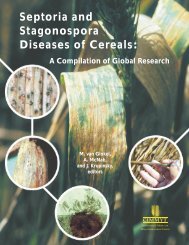Section 3 (Crop Management)
Section 3 (Crop Management)
Section 3 (Crop Management)
Create successful ePaper yourself
Turn your PDF publications into a flip-book with our unique Google optimized e-Paper software.
Tripathi<br />
It is necessary to manage acid upland soil of Nepal for sustaining or increasing crop productivity and<br />
maintaining soil fertility. Therefore, the objectives of the study were (I) to manage the marginal maize<br />
production system with the use of organic manure and inorganic fertilizers, (ii) to synchronize nitrogen<br />
requirement through organic and inorganic sources, (iii) to identify limitation of nitrogen, phosphorus and<br />
potassium nutrients in different agro-climatic conditions, and (iv) to select acid soil tolerant maize<br />
germplasms for the acidic areas.<br />
Materials and Methods<br />
Maize-based system<br />
The experiment was conducted in the marginal rainfed upland (bariland) of Agriculture Research<br />
Station, Lumle (1660 m asl). Before starting the experiment in the summer of 1997, wheat crop was<br />
grown in the experimental field in winter of 1996 without applying any manure or fertilizer in order to<br />
create soil homogeneity. The field trial was started in 1997 and continued upto 2000 with maize and<br />
millet was relayed. Millet was grown on the residual nutrients applied to maize. Maize was sown on the<br />
last week of march each year and millet was transplanted 10 to 11 weeks later after maize slowing. Maize<br />
and millet were harvested in second week of September and last week of November respectively. Bean<br />
was grown as mixed cropped with maize and was sown during second week of April (when maize started<br />
germinating). Bean was harvested as fresh vegetable in the first week of August. Similarly, pea was<br />
relayed with millet and was sown in the first week of November. It was harvested during the second to<br />
third week of March. Incorporation of bean and pea residues were done in the last week of August and<br />
March respectively in treatments of plus residues only. The above experiment was carried out in the same<br />
plots and terminated after four years (2000). The site of the experiment was changed from marginal<br />
rainfed upland to medium fertility rainfed upland during 2001 and all the treatments and planting was<br />
followed similar to that of marginal rainfed upland.<br />
The experiment was designed in a randomized complete block with three replications. There were ten<br />
different treatments comprising organic and inorganic nutrients. At the beginning of the experiment,<br />
composite soil samples to a depth of 25cm were collected from all three replications during 1997 and<br />
2001 both from marginal and medium rainfed uplands (Table 1). Soil of marginal upland was very<br />
strongly acidic (pH4.42), total N was low (0.18%), available P was medium (5.61 ppm), exchangeable K<br />
was low (0.15me/100g) and organic carbon was medium (2.22%) but soil of medium fertility has medium<br />
acidity (pH 6.00), total N was medium (0.37%), available P was very high (337 ppm), exchangeable K<br />
was medium (0.3 me/100g) and organic carbon was medium (3.78%). Every-year, the farm yard manure<br />
was analysed before applying in different treatments. Nitrogen content in FYM was 1.63% (on dry basis)<br />
which was applied in the marginal land from 1997 to 2000. However, N, P and K contents in the FYM<br />
applied in medium fertility soil in 2000 were 2.67%, 1.37% and 1.73% respectively on dry basis. The<br />
gross experimental plot size for maize was 9m 2 (3m63m) and net harvested area was 4.5m 2 (3mX1.5m) in<br />
infertile marginal upland trial and 12m 2 (4m63m) and 6.0m 2 (4m61.5m) as in medium fertility trial of<br />
2001. During maize harvest, maize plant population and grain yields were adjusted in per hectare basis.<br />
The moisture content of maize and finger-millet grains were adjusted at 12% moisture.<br />
Analysis of variance on grain of maize and finger-millet were performed by MSTAC and treatment<br />
differences were compared by least significant differences (LSD).<br />
Synchronizing N-requirement with organic and inorganic fertilizer<br />
The field experiment was conducted in a randomized complete block design with three replications in<br />
farmers' field of Lumle during 2000 and ARS, Lumle center during 2001. There were fourteen treatments<br />
- 283 -









